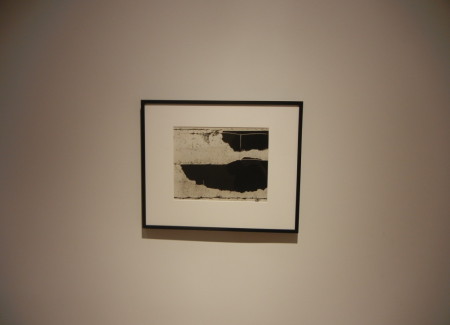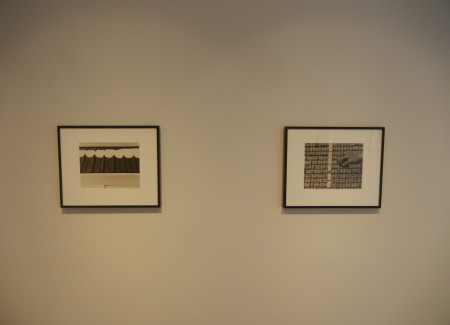JTF (just the facts): A total of 13 black and white photographs, framed in black and matted, and hung against white walls in the single room gallery space and the entry area. All of the works are vintage gelatin silver prints, made between 1956 and 1960. All of the prints are sized roughly 11×14 (or reverse), and no edition information was provided on the checklist. The show also includes two of the artist’s wire sculptures from the 1980s. (Installation shots below.)
Comments/Context: Coming out of the intense national trauma at the end of World War II, Japanese photography was obliged to reinvent itself. While in the previous decades Japan had developed its own soft focus Pictorial movement and its own beginnings of clean lined Modernism, those artistic ideas were basically made obsolete when faced with the widespread destruction in the aftermath of the atomic bombs; they didn’t match the gritty reality on the ground in any shape or form. As a result, something new had to rise up out of those demoralizing ashes, and many now well-known photographers (Tomatsu, Kawada, Hosoe, Fukase, and later Moriyama just to name a few) searched for innovative and experimental ways to capture the raw and conflicted emotional landscape of that period.
Shozo Kitadai clearly wrestled with many of these same late 1950s aesthetic issues. As a member of the newly formed (at that time) avant-garde collective Jikken Kobo, he was not only a photographer but a sculptor and a painter, and he brought an interdisciplinary mind set to the artistic challenges of creating a wholly new path forward.
Kitadai’s photographs from this period struggle with the clash of traditional Japanese culture and the imperatives of modern transformation brought on by the need to rebuild much of the country’s infrastructure. At times, his pictures have a strong echo of the Bauhaus, from their vertiginous high angled views of modern architecture to their honorific regard for meticulous craftsmanship. Columns of smooth concrete and arcs of building facades soar upward with aspirational clarity and technological bravura. Even a high contrast image of broken cement and wires feels forward thinking rather than ruined.
Kitadai’s crisp formal views of more traditional Japanese subjects feel like an attempt to infuse them with a similar dose of modern energy. Half circle wooden shoyu barrel tops are stacked in a neat geometric line, while a display of printed family name tiles becomes a dense grid of squared off characters. Ornate wigs gather on simple wooden stands, bold vernacular signage is isolated into a graphical set of shapes, and a fan is transformed into a nearly abstract squiggle. Even nature is co-opted, from the scalloped lines of melting snow on a traditional roof (white on black) to the reaching tendrils of vines growing up a stucco wall (black on white). His prints are consistently rich and powerful, seething with quiet intensity.
In Kitadai’s post-war photographs, we find a kind of hyper-sensitive, amplified attention that brings everyday details into sharp focus. His views aren’t brash and angry or ironic and disillusioned, but somehow annealed and made stronger by an urgency to reconnect with both the old and the new. His pictures rumble with coiled positive energy, as though looking again for the first time, searching for the cultural signposts and technological innovations that could be used to build the future.
Collector’s POV: The prints in this show are either priced at $12000 or NFS (not for sale). Kitadai’s photographs have little secondary market history in this country, so gallery retail likely remains the best/only option for those collectors interested in following up.











